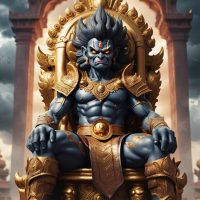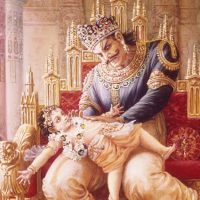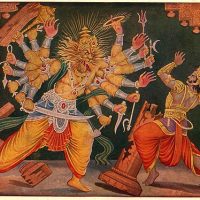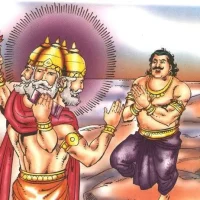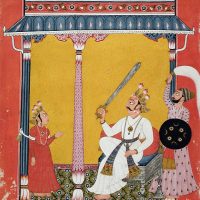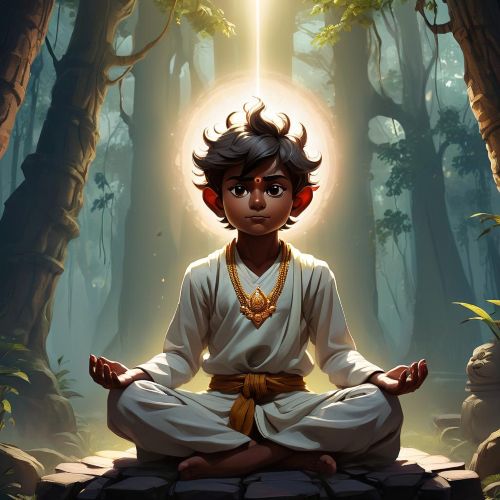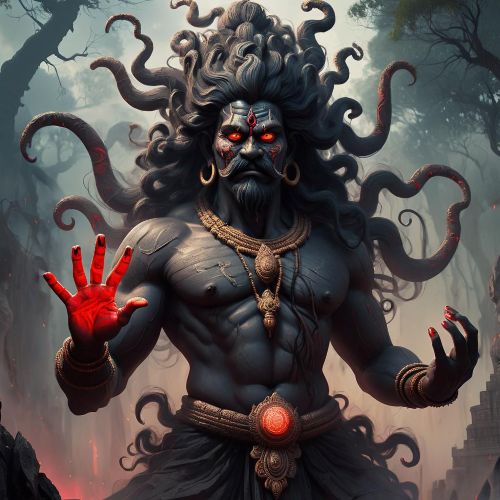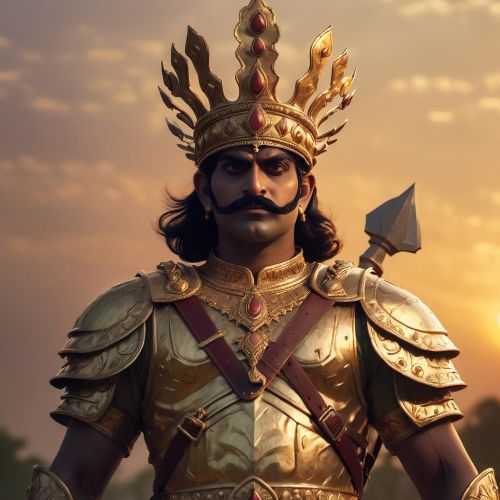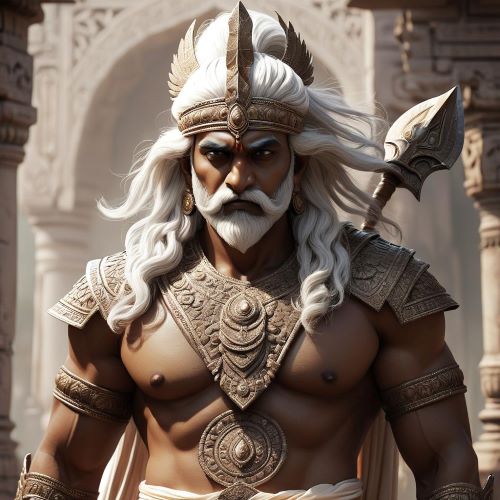Hiranyakashipu : The Blessed Demon
Listen
At a glance
| Description | |
|---|---|
| Origin | Indian Mythology |
| Classification | Mortals |
| Family Members | Kashyapa (Father), Diti (Mother), Hiranyaksha (Brother), Kayadhu (WIfe), Prahalad (Son) |
| Region | India |
| Associated With | Royalty, Narasimha |
Hiranyakashipu
Introduction
Hiranyakashipu, one of the most feared and fascinating figures in Hindu mythology, represents the eternal conflict between arrogance and devotion. As the Asura king who defied the gods and dared to challenge Lord Vishnu himself, his tale serves as a powerful allegory about the limits of mortal power and the triumph of righteousness. Found primarily in texts like the Bhagavata Purana, Vishnu Purana, and Mahabharata, Hiranyakashipu’s story revolves around his unrelenting quest for immortality, his persecution of his pious son Prahlada, and his eventual downfall at the hands of Vishnu’s Narasimha avatar. His life captures the essence of human pride pushed to its divine reckoning, making him one of the most memorable villains in Indian mythology.
Physical Traits
Ancient scriptures and artistic depictions describe Hiranyakashipu as a towering and awe-inspiring figure radiating golden brilliance. His name itself—Hiranya (gold) and Kashipu (soft bed)—implies not only his love for material wealth but also his opulent appearance. With a muscular frame, glowing eyes, and sharp features, he embodied strength and authority. His golden armor and crown symbolized his power, while his fierce expression reflected his inner rage and ambition. Legends recount that after performing his severe penance, his body became so radiant that it appeared to glow like molten gold. His very presence invoked terror among gods and mortals alike, a testament to his physical and spiritual might.
Family
Hiranyakashipu was born to the sage Kashyapa and Diti, daughter of Daksha Prajapati, placing him within a powerful lineage that straddled both divine and demonic realms. His younger brother, Hiranyaksha, was slain by Lord Vishnu in his Varaha (boar) avatar—a pivotal event that ignited Hiranyakashipu’s deep hatred toward Vishnu. His wife, Kayadhu, was renowned for her virtue and devotion. While pregnant with Prahlada, she was sheltered by the sage Narada, who imparted spiritual wisdom to the unborn child, sowing the seeds of Prahlada’s unwavering devotion to Vishnu. Hiranyakashipu also had other children—Anuhlada, Hlada, Samhlada, and Shibi—though Prahlada’s piety and defiance would eventually bring about the family’s downfall. His sister Holika too played a significant role in his legend, as her attempt to kill Prahlada by fire became the origin of the Holika Dahan ritual celebrated during Holi.
Other names
The name Hiranyakashipu carries layers of symbolic meaning, derived from Hiranya (gold) and Kashipu (cushion or pleasure), encapsulating his obsession with wealth, sensual pleasure, and material dominance. In some texts, he is also called Hiranyakasipu or Hiranyakashyap, minor variations that appear across different Puranic manuscripts. Epithets such as Daitya Raja (King of the Daityas) and Asura Samrat (Emperor of the Asuras) further emphasize his reign over the demon clans and his role as a ruler who usurped the heavens. These titles not only signify his worldly conquests but also his attempt to position himself as the supreme being, above gods and cosmic order itself.
Powers and Abilities
Hiranyakashipu’s ascent to power was marked by one of the most intense acts of austerity described in Hindu lore. He performed severe penance to appease Lord Brahma, standing motionless for thousands of years until even the gods grew fearful of his resolve. When Brahma appeared before him, Hiranyakashipu demanded a boon that effectively made him invincible. Denied absolute immortality, he framed conditions that circumvented mortality itself—he could not be killed by man or beast, inside or outside, during the day or night, on earth or in the sky, or by any weapon. Empowered by this ingenious boon, he conquered the three worlds, dethroned Indra, and forced gods and men alike to worship him. His power extended beyond physical might—he possessed the ability to alter his form, summon cosmic energies, and wield weapons with unmatched skill. Yet, his arrogance blinded him to the one truth that his son Prahlada repeatedly reminded him of: that divine will transcends mortal cunning.
The culmination of his story reveals the divine genius of Vishnu’s Narasimha avatar—half man, half lion—created specifically to bypass the conditions of Hiranyakashipu’s boon. Narasimha appeared at twilight (neither day nor night), on the threshold of a palace (neither indoors nor outdoors), and slew the demon with his claws (neither weapon nor tool), tearing him apart while seated on his lap (neither earth nor sky). This act fulfilled every loophole of Brahma’s boon, illustrating that divine justice is inescapable, even for those who challenge it with intellect and power.
Modern Day Influence
The legacy of Hiranyakashipu endures far beyond ancient scriptures, permeating modern culture, art, and philosophy. His story forms a central theme in the celebration of Holi through the ritual of Holika Dahan, symbolizing the triumph of faith and righteousness over arrogance and evil. The burning of Holika each year serves as a reminder of Hiranyakashipu’s tyranny and the divine protection afforded to his son Prahlada.
In literature and performing arts, the tale of Hiranyakashipu continues to inspire reinterpretations. Classical Indian dance forms such as Kathakali and Bharatanatyam have dramatized the Narasimha episode, showcasing the epic clash between devotion and hubris. In temple art, sculptures of Narasimha slaying Hiranyakashipu are found throughout South India—in places like Ahobilam, Hampi, and Simhachalam—depicting the moment of divine retribution with striking realism and emotion.
Modern cinema and animation have also embraced this myth. The upcoming 3D animated feature Mahavatar Narasimha, produced by Hombale Films, reimagines the story for a global audience, emphasizing its philosophical depth and moral lessons. The film’s meticulous attention to scriptural accuracy and cultural detail has been praised for its portrayal of the timeless struggle between faith and defiance.
In contemporary spiritual discourse, Hiranyakashipu serves as a cautionary symbol of unchecked ego and material obsession. His story is invoked in sermons and teachings to illustrate that power devoid of humility leads to destruction. His opposition to his own son’s devotion is often interpreted as the inner battle between the human ego (Hiranyakashipu) and the divine consciousness (Prahlada). Even outside religious contexts, his character finds relevance in discussions about authoritarianism, greed, and the moral consequences of power.
Ultimately, Hiranyakashipu’s downfall is not merely a mythic episode—it is a moral parable that continues to echo across generations. His tale reminds humanity that no matter how vast one’s strength or intellect, defiance against the moral and cosmic order brings inevitable ruin. Through Narasimha’s intervention, the story reinforces the idea that divine justice operates beyond mortal comprehension, upholding the balance of dharma across time.
Related Images
Source
Apnisanskriti. (2017, March 27). The story of Hiranyakashipu and Prahlada – Narsimha avatar. https://www.apnisanskriti.com/story/the-story-of-hiranyakashipu-and-prahlada-narsimha-avatar-61
Wikipedia. (2002, October 5). Hiranyakashipu. https://en.wikipedia.org/wiki/Hiranyakashipu
Jay Penner Blog. (2024, December 31). The story of Hiranyakashipu from Indian mythology. https://jaypenner.com/blog/the-story-of-hiranyakashipu-from-indian-mythology
Sharma, V. (2020, August 25). Hiranyakashipu – The Asura Who Wanted to Be the Supreme Lord of the Universe. Abt Indian Mythology. https://abtindianmythology.wordpress.com/2020/08/26/hiranyakashipu-the-asura-who-wanted-to-be-the-supreme-lord-of-the-universe/
Jagat Guru Rampal Ji. (2024, June 8). Prahlada & Hiranyakashipu: The Secret Facts You Must Know. https://www.jagatgururampalji.org/en/great-devotees/bhakta-prahlada/
Vedabase.io. (2025, July 4). Hiraṇyakaśipu Terrorizes the Universe. https://vedabase.io/en/library/sb/7/4/
My India My Glory. (2019, March 22). Holi, Holika and Hiranyakashipu: Dispelling Dalit… https://www.myindiamyglory.com/2019/03/23/holi-holika-and-hiranyakashipu-dispelling-dalit-oppression-myth/
Britannica. (2025, September 24). Hiranyakashipu | Hindu mythology. https://www.britannica.com/topic/Hiranyakashipu
Bhaktivedanta Swami Prabhupada, A. C. (1972). Srimad Bhagavatam: Canto 7 – The Science of God. Bhaktivedanta Book Trust.
Doniger, W. (2009). The Hindus: An Alternative History. Penguin Books.
Basham, A. L. (1954). The Wonder That Was India. Grove Press.
Dalal, R. (2010). Hinduism: An Alphabetical Guide. Penguin Books India.
Pattanaik, D. (2014). Myth = Mithya: A Handbook of Hindu Mythology. Penguin Books India.
Frequently Asked Questions
What is lorem Ipsum?
I am text block. Click edit button to change this text. Lorem ipsum dolor sit amet, consectetur adipiscing elit. Ut elit tellus, luctus nec ullamcorper mattis, pulvinar dapibus leo.
What is lorem Ipsum?
I am text block. Click edit button to change this text. Lorem ipsum dolor sit amet, consectetur adipiscing elit. Ut elit tellus, luctus nec ullamcorper mattis, pulvinar dapibus leo.
What is lorem Ipsum?
I am text block. Click edit button to change this text. Lorem ipsum dolor sit amet, consectetur adipiscing elit. Ut elit tellus, luctus nec ullamcorper mattis, pulvinar dapibus leo.
What is lorem Ipsum?
I am text block. Click edit button to change this text. Lorem ipsum dolor sit amet, consectetur adipiscing elit. Ut elit tellus, luctus nec ullamcorper mattis, pulvinar dapibus leo.
What is lorem Ipsum?
I am text block. Click edit button to change this text. Lorem ipsum dolor sit amet, consectetur adipiscing elit. Ut elit tellus, luctus nec ullamcorper mattis, pulvinar dapibus leo.


